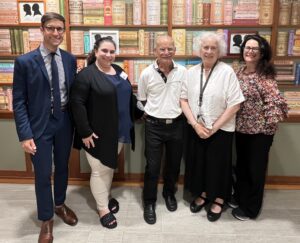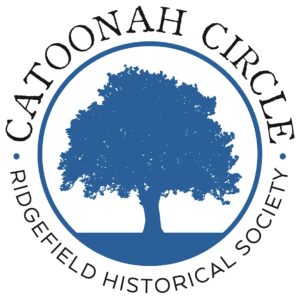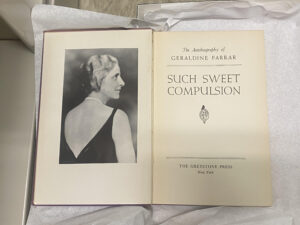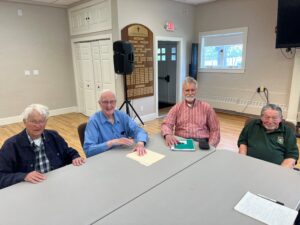The feature article in April 2021 edition of the SHJ centers on letters written nearly a century and a half ago to Mary Christie Seymour (known as “Mamie”) that detail what topics were of interest in Ridgefield during the post-Civil War period.
Words of wisdom from ‘Papa’ are a window into an eventful life
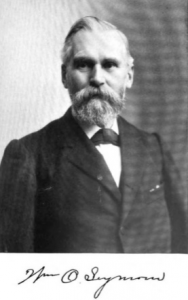
Letters written nearly a century and a half ago bring to life a family that has been part of Ridgefield since its earliest days and show how education was prized. From the Ridgefield Historical Society archives, a collection of letters to Mary Christie Seymour (known as “Mamie”) details what topics were of interest in Ridgefield in the post-Civil War period.
While the volume of letters preserved is unusual, their topics are frequently just the day-to-day events of small-town life — visits from family and friends, the weather, church services and sermon topics, and regular words of encouragement for Mamie. A selection from 1876, when she had just begun her studies at Mt. Holyoke Female Seminary in South Hadley, Mass., not only demonstrate her family’s interest in her studies, but also touch on events both local and national.As quotidian as the letters may seem, they contain details that will add to future studies of Ridgefield and its people. When Mamie Seymour was growing up, she became accustomed to receiving letters from her father, William O. Seymour, who was a railroad design engineer and often away from home. He began with nearby railroads, for a time in New York, where Mamie went to elementary school. After a stint as chief engineer for the New York, New Haven & Hartford Railroad, he began working on Midwestern lines, specializing in designing bridges.


Born in 1833, William Oscar Seymour was educated at the West Lane School and prepared for college with Professor Lee Edmond of the Florida District, whose students were mainly from New York City. Mr. Seymour then attended the Amenia (N.Y.) Seminary. He returned to Ridgefield with the intention of becoming a grammar school teacher, and had taught in New Canaan in 1849, but eventually decided there was more of a need for his efforts as a “high school” teacher. His High Ridge Institute was established in the late 1850s and he and his family lived and kept the school at what has been known as the “Peter Parley House,” the former home of author Samuel G. Goodrich. Up to 40 boys, both day and boarding students, attended.
Mary Christie Seymour was born in 1857 to Rebecca Sproull Seymour and William O. Seymour and spent her early years at the school. Her sister, Augusta (later Mrs. Howard D. Smith) was born in 1863. By 1869, Mr. Seymour saw his future in railroads. He had taught civil engineering to young men and now he was going to use his knowledge directly.
Starting out with the New York, New Haven and Hartford Railroad, he assisted in surveying for a new line; by 1877, he was the railroad’s chief engineer. He went to a Massachusetts railroad in 1881 but soon headed west, where he worked for the Wisconsin Central and helped build a 104-mile line from Chippewa Falls, Wisc., to St. Paul, Minn., including a 2,239-foot long iron bridge on stone abutments across the St. Croix River. Another line he built ran 124 miles from Chicago to Schleisingerville, Wisc.
He returned to his hometown in 1887 and was soon appointed one of three Connecticut railroad commissioners, selected by a fellow Ridgefielder, Gov. Phineas Lounsbury. He remained a commissioner until his death 24 years later in 1911, and also served as a probate judge, a state representative, a borough warden, and a member of the Board of Estimate. He was vice-president of the First National Bank of Ridgefield, which he helped found in 1900. In 1908, he was the chairman of the town’s Bicentennial Celebration, honoring the founding of Ridgefield by settlers who included his ancestor, Thomas Seymour. (Fifty years later, his great grandson, Karl Seymour Nash, was chairman of the town’s 250th anniversary celebration.)

History was a topic of special interest to the Seymour family in 1876, as it was on the minds of the entire American public: The nation was celebrating its founding with the Centennial International Exhibition in Philadelphia, the first World’s Fair to be held in the United States.
In his letter to Mamie dated Sept. 4, 1876, Mr. Seymour says, “Every body in New England seems to be going to the Centennial this week. The trains running in that direction have been loaded all day, having 20 or 25 cars, crowded. The weather since Saturday has been cool and pleasant, certainly a very agreeable change after the hot summer.”
The following week, “Papa” reports, “On my way home Saturday night, I saw Miss Merwin and Sarah Clark on the cars just returning from a week at the Centennial.” A letter from Mamie’s mother that week tells about visitors and contacts from friends, including a note from a friend of Mamie’s, Emma Bardwell, “who is teaching.” Among the visitors was “Hattie,” who enjoyed her time with the Seymours.“ We were invited to the Olmsteads while she was here, on the occasion of Jennie’s birthday. The Gilbert party were there and we had a very pleasant time. Then last Friday we went to the Mission Band at Cousin Minnie’s and she enjoyed that.”
The letter also contains a tantalizing paragraph from her mother: “You need not fear about what you have confided to her, for I am quite sure she has not enlightened Wilton people at all in regard to your affairs.” Unfortunately, we have only one side of the correspondence, but we do know that the man Mamie married in 1881, David Law Jones, was living in Wilton.
In a letter on Sept. 19, Mamie’s father mentions her report that she had received many letters from friends and relatives, which he says must have made her happy, but adds a parental warning: “I am thinking that if you reply to them all, it must take some of your time, but I hope it will not seriously interfere with your studies. I hope you will not be much troubled with homesickness, for you have good judgment enough not to make yourself very unhappy on that account. The school terms will soon pass away and you will enjoy your house all the more on account of your absence. I dislike to have you away, and we miss you more and more, as you grow older. I know you will make a better woman on account of the advantages you are enjoying and therefore we reconcile ourselves to it because it is best. I suppose after you have been through a course in Astronomy you will be able to look upon the sky with new wonder and interest.”
“Papa” adds a gentle admonishment: “I am rather sorry to hear you are getting more fleshy again for I think you look better and probably feel better when you are not as fleshy. Eight pounds is quite an increase for two weeks.” After some more news of Ridgefield friends heading to the Centennial, he closes. “I hope you will get along nicely and keep happy and well. Good night, with much love, Papa.”

Anyone who’s ever received a letter from a younger relative will recognize the efforts of Mamie’s sister Gussie: “Sept. 22, 1876, My Dear Sister, I can not think of much to write about but I must tell you about the bread I made this morning. It was so late I did not know what was the matter…. I took some flower [sic] and mother said mix it together and that is what I did. We are all well and hope you are. I got a new pair of earrings they are real nice the next thing is a dress. Mrs. James sent me a pair of stockings, red with a maroon stripe of white, like the children and Bess’s pitcher and sampler. I can not think of enny thing more. Love to all and to you, Gussie.” (Augusta Dodge Seymour Smith, 1863-1934).
In late September, W. O. Seymour writes to his daughter from his office and explains that he’s been away from home but intends to return to Ridgefield for a “musical reception at Dr. Adams,” which had been postponed for a night. (“Doc” Adams, early baseball great, retired to Ridgefield and was a founder and first president of the Ridgefield Savings Bank. His house was where Ballard Park is today.) “They are having very cold uncomfortable weather for the fair,” he wrote, “and I conjecture that attendance will be down.” (That would be the Ridgefield Agricultural Society Fair, Sept. 25-29, 1876.)
“You ask if I am going to the Centennial,” continues Mr. Seymour. “If nothing happens to prevent, I intend to spend a part of the second week in October in Philadelphia and if possible I hope to have Mama go with me.”
Then, Papa offers some academic advice: “I am afraid you are not very much interested in the course of lectures on Astronomy, although I hope you will get some valuable information from them, even if you are not able to understand them fully at least. I hope you will neither be writing letters nor reading novels during their delivery. I am glad you like History and Geometry. History you can pursue by a course of interesting reading after you leave school, in fact you can only expect to get some of the general outlines of it in school. I think you have a natural taste for mathematical studies and if it was thoroughly cultivated you might become proficient in its various branches.”
Life away at school offered more than lectures, and Mamie apparently kept her family well apprised of her social life. Her father refers to an outing to Amherst in his Oct. 14, 1876, letter: “You need not cause yourself any uneasiness about my seriously thinking you rude or improper in your conduct. I did not expect you would be, but knowing the temptations to which young school girls are exposed I took occasion to caution you against anything of the kind. I am certainly very glad you went to Amherst for you may never have another opportunity to go.”
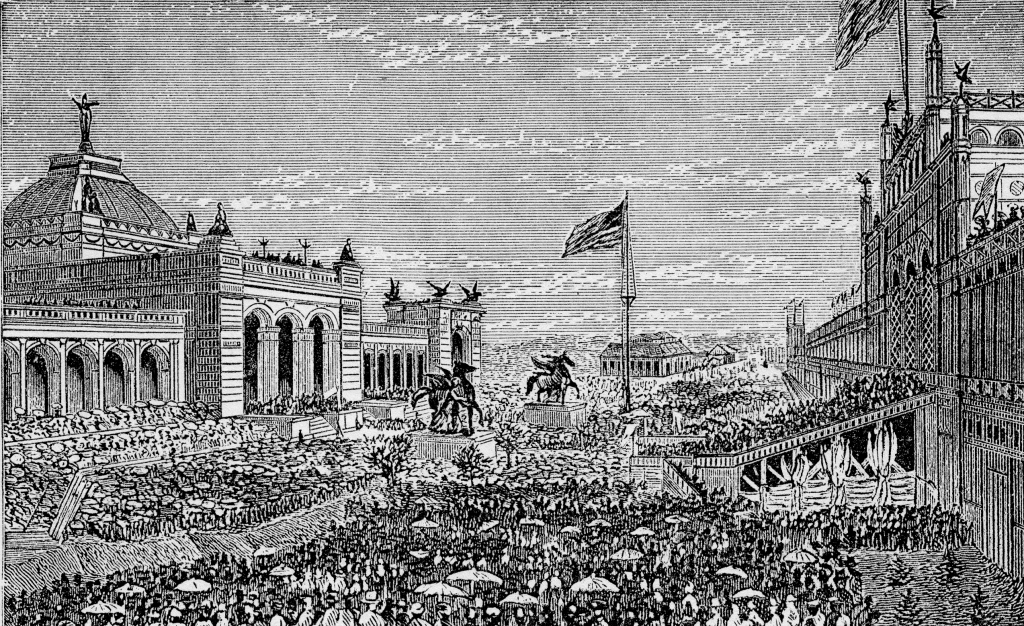
In the same letter, Mr. Seymour reports plans to finally go to the Centennial, which opened May 10 and would conclude on Nov. 10.
On Oct. 23, he reports: “Well, like all the rest of the world, we have now been to the Centennial, and are back again at our ordinary duties. We returned home Friday night and Mama took her bed that night and has been out of it scarcely since, although she came down to dinner yesterday and was up to get my breakfast for me this morning before I came away, but looked as if she ought to go back again. She has a sore throat but says she is not much sick and will be about again as usual in a few days, and I sincerely hope she may.”
As Christmas approached in 1876, Mamie was struggling somewhat and her father’s Dec. 22 letter focused on her coming examinations. She would apparently be staying at school for the holiday, so her father followed his bracing words with some happier thoughts:
“One word to begin with regarding the History, and I say it for your good and realizing the difficulties you have to contend with. I am not willing you should give it up. You can learn it, and you must, if it takes twenty-five years (if your life and health is spared that long). Don’t be discouraged, and give up in despair, but persevere and overcome the task, not let the task overcome you. When you have accomplished it you will be the stronger to grapple with and overcome the next difficulty that presents itself. Don’t attempt to commit it word for word to memory, but remember the principal facts, and relate them in your own language. Other girls have done it; so can you. You have spent one series on it; now let this series complete it. You may not be perfect at every recitation, but master it without fail, so that you can undergo a satisfactory examination in it. And don’t be displeased because I speak my mind so plainly, for I mean it kindly and for your good. Life is not a smooth sea, with fair winds, but difficulties and obstacles are met with at every step which must be surmounted and overcome. Get the habit now in youth of facing every difficulty with determination to overcome it. You may fail once, twice, many times, but persevere and never give up and you will conquer at last.”
“Now,” he continued, “we will drop this subject and take a more agreeable one. We will send you a box tomorrow, which I hope you will receive the same day, although the Express Co’s are so crowded with boxes and bundles that they are sometimes unable to forward them the same day they are shipped. So don’t be disappointed if it should not come until Monday. It will not contain many valuable presents, I am sorry to say, but if I had the means with which to procure them, I should not lack the disposition. But I hope you will be satisfied with small things. I endeavored to get some fruit today for you, but I could get nothing but some oranges, and they cost 50 cents a doz. I saw no bananas that looked fit to eat and they were so high I could not afford to buy them. Mama has prepared some things for you at home, which perhaps will be as good as anything we could buy. We all send our love, and lots of good wishes, and these are worth more than anything else we can send. Merry Christmas from Papa.”

Mary Christie Seymour’s adventurous life continued after she returned to Ridgefield. She married David L. Jones, a Wilton native, on Dec. 22, 1880, at the Seymour home, then on Washington Street in South Norwalk, where the family had moved a few years before. (The location was much more convenient for the Chief Engineer of the New York, New Haven & Hartford Railroad, with direct access to the main train line.)
The Joneses lived for a decade in Colorado where he had a copper claim; their daughter Christie Law Jones was born in 1882 in Wilton and their daughter Helen Wallace Jones was born in Denver, Colo., in 1892. Unfortunately, the collection of letters ends before Mamie’s wedding, nor are there any letters from her time in Colorado.
The family returned to Ridgefield and settled in Farmingville in the 1890s at Walnut Grove Farm. Mr. Jones operated a dairy from this farm and grew crops at his Fairview Farm along Lee Road. Daughter Christie Law Jones also studied at Mt. Holyoke and was an assistant at the Ridgefield Library before she married Howard Patterson Nash. Widowed when her five children were quite young, she resumed her work at the library, retiring in 1956. She died in 1967. Helen married Llewellyn Crossman and died in Richmond, Va., in 1973.

Mamie Seymour Jones died on April 10, 1910; that week’s Ridgefield Press recorded her passing on the front page: “The entire community was shocked and grieved last Sunday night when it learned that Mrs. David L. Jones had passed away. She had been ill but five days… Mrs. Jones had a large circle of friends by whom she was greatly beloved. She was a woman of very quiet, lovable disposition, devoted to her family and her home life. She will be greatly missed in her church where she was an untiring worker.
“Mrs. Jones was a daughter of Hon. William O. Seymour and is survived by her father, husband, two daughters, Mrs. Howard P. Nash and Miss Helen W. Jones, and by her sister, Mrs. Howard D. Smith. She was born in Ridgefield 52 years ago, and most of her life has been lived here. The funeral services were held at the Congregational church yesterday afternoon. … There was a large attendance at the funeral services and the floral tributes were numerous and beautiful.” William O. Seymour died a year later and David L. Jones in 1917.
The D.F. Bedient Company, “Dealer in Furniture, Hardware, Groceries, and General Merchandise,” was then also “Funeral Director and Embalmer”; the bill for Mary C. Jones services was $54.00.
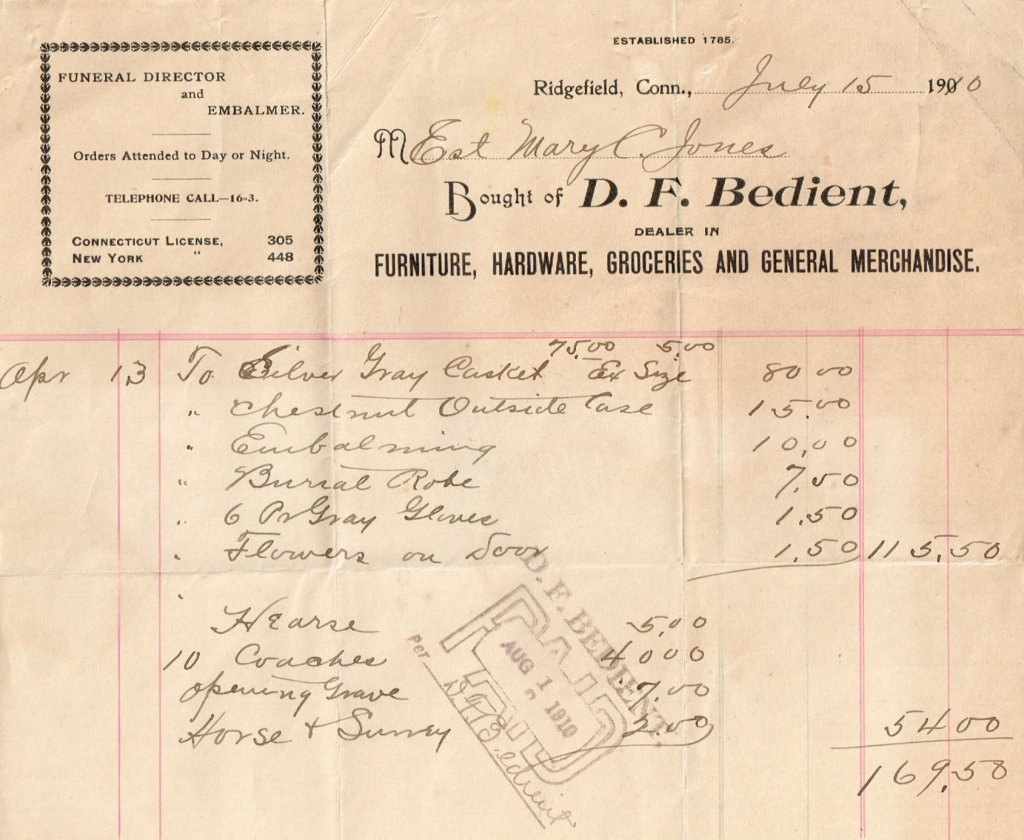
President’s Message
A very happy spring to everyone! By now, I hope many of you are vaccinated and making plans to see friends and family again. We too are making plans to reopen the Scott House in June. In preparation of a June 1 opening and thanks to the generous support from the Richardson Fund, we have been busy refurbishing our office space with beautiful new furniture and updated computers and software. The grant has also provided the opportunity to redesign our archival vault with new carriages. This new design will maximize our space with state of the art equipment to store and organize the many treasures in our archives. It will be extra special to welcome our volunteers and staff back to a clean and freshly outfitted space.
In addition to the Scott House interior, our website is getting a new look as well. The entire site is being rebuilt and redesigned with the intent of providing easy access to the many resources we have to offer for research, inquiries and exploration.
And finally on tap this spring, we will hold our first-ever fundraiser, on May 30th. The event, Old News is Good News, includes a three-course dinner by Sarah Bouissou, a video of century old newspaper readings from our archives and the feature film, News of the World starring Tom Hanks.
All you have to do is a) buy tickets on our website, b) choose your meal option, and c) choose your pick up time from the Scott House on the 30th. The weekend of the event you will receive a link to the movie to enjoy at your leisure over a 72 hour period. All proceeds support the Historical Society and with your help, we hope for a successful turnout!
As always, stay tuned by checking our website and weekly e-blasts to see the many programs we have on. We look forward to opening our doors to you again in June, so please stop by to see what’s new!
TRACY SEEM,
President,
Ridgefield Historical Society

